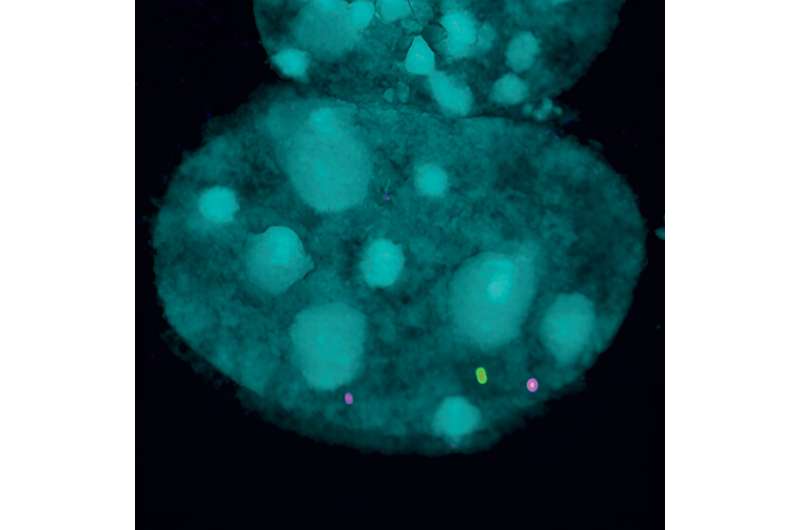Home » Health News »
Chance discovery shows promise in finding treatment for genetic disorder

Researchers have gained insight into how a toxic protein, known to trigger muscular dystrophy, could be deactivated—a pre-clinical discovery that could spearhead a treatment for the debilitating disease.
Facioscapulohumeral muscular dystrophy (FSHD) is a progressive, muscle-weakening condition characterized by the death of muscle cells and tissue. It is currently incurable and untreatable.
The discovery, from a global research collaboration led by WEHI, found a gene linked to FSHD can be safely boosted in the lab to potentially disable the toxic protein, bringing the team closer to finding a future treatment for the genetic condition.
FSHD affects around 870,000 people worldwide, including more than 1,000 Australians.
The inherited disease is caused by the production of a toxic protein that cannot be effectively “switched off.” SMCHD1, a gene discovered by WEHI researchers in 2008, is critical for switching off the production of this toxic protein.
WEHI’s Professor Marnie Blewitt leads the only drug discovery effort in the world that leverages in-depth understanding of SMCHD1 to design novel therapies to treat degenerative disorders like FSHD.
Prof Marnie Blewitt, Acting Deputy Director and Laboratory Head at WEHI, said it was invaluable to know the gene can be safely boosted in the lab, after years of research flagging this possibility.
“While most people with FSHD have a normal life expectancy, their quality of life is significantly decreased due to the challenges they experience because of the serious muscle weakness brought on by this disease. We want to improve their health and quality of life,” she said.
“The less SMCHD1 people have, the worse the disease symptoms.”
“That’s because SMCHD1 normally silences the expression of the protein known to destroy muscle function in FSHD. When this process malfunctions, it causes this toxic protein to be produced in excess, impacting healthy muscles.”
“This is why our team has dedicated years to finding ways to boost SMCHD1 function, in hopes of restricting the production of this toxic protein and protecting muscle function.”
In a collaboration with Leiden University Medical Centre (Netherlands), the team found that in pre-clinical models of disease, boosting of SMCHD1 function limited the production of the toxic protein, with no adverse side-effects.
“The next step is to figure out how to translate these milestone findings to benefit humans, by determining the best way to boost SMCHD1 and its silencing powers to hopefully find a cure for FSHD.”
New insight
The research, published in Nature Communications, also rewrites a previous discovery made about how SMCHD1 executes its silencing capabilities.
In 2018, WEHI researchers revealed SMCHD1 gathers together genes that it normally silences into specific regions of the nucleus in each cell.
Andres Tapia del Fierro, the paper’s first author and a Ph.D. student in Prof Blewitt’s lab, said his findings showed the gene’s gathering ability is not actually connected to its silencing functionalities.
“This was an unexpected, yet crucial finding, that really took the team by surprise,” Tapia del Fierro said.
“Without this fundamental discovery, we would still think these two functions are linked.”
“This would have seen us dedicate years towards trying to find new ways to boost SMCHD1 function, by boosting its ability to gather genes—which we now know won’t work.”
Researchers are instead focusing on other activities of SMCHD1 that could potentially be boosted to enhance its gene-silencing abilities.
“Some of the most significant scientific discoveries have come from these types of mechanistic findings, that transform our understanding and allow us to break apart a protein’s different activities to analyze its various roles,” Andres Tapia del Fierro said.
“In order to create therapeutics against SMCHD1, we need to have an in-depth understanding into how the protein works.”
“While we don’t yet know how to boost SMCHD1 function in a human context, knowing what won’t work allows us to start a process of elimination that will bring us closer to hitting the molecular jackpot.”
“Every finding also allows us to gain a deeper understanding of the complex SMCHD1 protein—and that is the beauty of scientific discovery.”
Multi-disciplinary collaboration
The findings were driven by a global collaboration, involving Leiden University Medical Centre (Netherlands), The Francis Crick Institute (UK), Agency for Science, Technology and Research (A*STAR) in Singapore, the Australian Regenerative Medicine Institute (Monash University) and WEHI’s structural biology, bioinformatics, genomics and imaging teams.
WEHI researchers are currently screening thousands of drug-like molecules in search of chemicals that can boost SMCHD1 activity. Promising molecules will then be refined to develop drugs to treat FSHD, or even prevent the disease in people carrying FSHD mutations.
The study, “SMCHD1 has separable roles in chromatin architecture and gene silencing that could be targeted in disease”, is now published in Nature Communications.
More information:
Andres Tapia del Fierro et al, SMCHD1 has separable roles in chromatin architecture and gene silencing that could be targeted in disease, Nature Communications (2023). DOI: 10.1038/s41467-023-40992-6
Journal information:
Nature Communications
Source: Read Full Article



